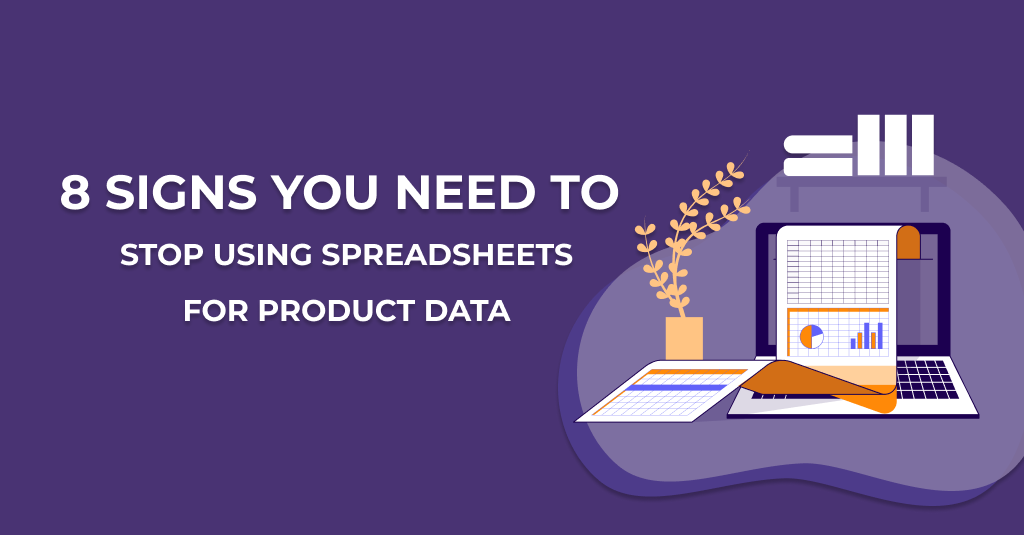How exciting it is to watch your eCommerce business take flight — being able to survive the rough patches, provide your customers with excellent experiences, and, watch it grow.
This growth also brings with it a need to adapt to the industry’s pace and make necessary changes to how you do business. Your teams expand, your processes are refined and you take a good look at the tools that make all your success possible.
We’ve previously discussed how spreadsheets are a great, low-cost way to begin handling product information for smaller brands. The low-cost nature, though, comes at a price, quite a few in fact. And as your eCommerce business scales, spreadsheets just won’t be able to keep up with you.
Here’s a checklist to help find the signs that you need to evolve how you handle product data. The more signs you check, the more severe your requirement is for a solution like a Product Information Management (PIM) tool.
Contents
The Signs: Spreadsheet or PIM?
You’re going multi-channel
As you scale, including more avenues and opportunities to sell makes sense. When you do, it’s important to ensure that the product information mentioned across these platforms is consistent and up-to-date. Spreadsheets don’t have the ability to be able to support publishing to multiple platforms, nor help ease the process. They’re setting your team up for tedious means of managing product content.
You have expanded the number of SKUs
While spreadsheets can help with managing fewer SKUs, as the number of products and/or their types scale, they won’t be able to keep up. This will render product details hard to locate, increase the risk of errors, and could potentially lead to missing information: all of which can impact the customer’s perception of your brand and negatively impact business processes.
You receive product content from other sources
Whether these sources are content aggregators such as DDS (Distributor Data Solutions), Trade Service or even product vendors, multiple sources of content also include multiple formats of receiving that content. An additional effort would need to be made by your team to update this information across their own records, ERP as well as the platforms featuring said products. These updates would also have to be tweaked to suit the format of their final destination.
Your team is growing
You’ve more people contributing to shared business goals: congratulations! This means you have more stakeholders that need to be informed of product data. Whether it is your marketing team or project managers, having a grasp of real-time information is crucial, something that spreadsheets aren’t fully equipped to allow.
While some versions of spreadsheets have moved to the cloud and offer collaborative features, they are not able to meet the specific requirements that teams will require, including security features such as authorizing access or tracking updates and errors. New team members may also struggle with understanding multiple formats and coping with the many processes involved with spreadsheets.
To err is human
Spreadsheets are a cesspool for errors and missing data. In fact, one study suggests that a whopping 90% of spreadsheets contain errors. The more information being handled, the greater the chances of errors. This is especially due to the fact that spreadsheets rely on manual updates and force teams to update destination platforms manually as well. Tracking these changes also becomes highly complicated when dealing with spreadsheets.
More real-time calls
What separates shots in the dark from actual business decisions is the right use of facts. Spreadsheets by their very nature are built to store data, not so much provide insights in real-time. This could lead to delays or decisions based on incomplete information, neither of which bodes well for your business.
You’re improving product content & looking at Digital Asset Management
Again, spreadsheets do contain data well but are not suited to enriching content. This includes creating a more conducive interface for writing product descriptions. An additional issue is the method in which the content is enriched, or where important digital assets such as product images and videos are stored and managed: which is beyond the scope of spreadsheets.
You have an ERP
Having an ERP does bring with it some information storing abilities, but not the kind that a PIM can offer – and certainly, not one spreadsheet can keep up with. Along with a host of disadvantages, spreadsheets can’t communicate with your ERP, eCommerce store, or content aggregators, requiring a level of intervention that is redundant at best and wasteful on most counts.
The Key Threats
By now, you’d have noticed a pattern in terms of when moving away from spreadsheets would benefit your eCommerce business. Continued use of spreadsheets while hitting even two of the above milestones could lead to:
Significant loss of time and effort
Having to update multiple spreadsheets, manually and on a frequent basis would lead to hours invested that will add up – sooner rather than later. This is time that your team could otherwise invest in tasks that are far more productive for the organization.
Increased risk of errors
A system that is reliant on manual intervention is extremely susceptible to human error. This can range from typos that may be off-putting to visitors, all the way to missing data that can lead to a significant impact on your eCommerce business and the way it is viewed by current and potential customers.
Higher costs
While a spreadsheet solution may seem low-cost at the get-go, over time the amount of time invested by your team and the costs incurred as a result of inconsistent data, communication gaps, and human errors will take its toll. In the long run, it would pay to have a more efficient solution in place, built specifically for the tasks of product information management and designed to circumvent these issues.
The Solution: PIM
It’s actually quite straightforward: for better product information management, get a Product Information Management (PIM) tool. Unlike a spreadsheet, a PIM is a centralized storage tool, designed specifically for handling product data across vast SKUs, your ERP and eCommerce platforms. With a PIM, you’d gain the following advantages:
Single source of truth
Since it is a centralized tool, it negates the need to access and maintain multiple copies of the same data. Instead, teams can import, edit and even export real-time data from one location, assured that it has been automatically updated across necessary business tools and platforms.
Secured business data
Security can become a pressing concern as you handle more data. PIMs are built to provide a secure means of storing and handling product information. You may even have the option to provide selective access to teams, preventing the misuse of data, better accountability and being able to trace changes made to the product data.
Saved time, effort, and costs
With a PIM in place, a lot of the aforementioned repetitive processes will be mitigated. This will lead to a drastic reduction in manual intervention, consequently reducing the scope for errors and missing data as well. With these risks prevented to a great degree, the costs associated with them will be too, opening up opportunities for your eCommerce business.
A solution that will keep up with your business
PIMs help businesses scale and keep up with demands as they do. Unlike spreadsheets that turn from boon to bane as organizations grow, a PIM is crafted to enable scaling and continue to provide support as businesses expand in terms of teams, product information, SKUs, vendors, and sources of product content, and even eCommerce stores.
Better customer experience = better sales
When your team and your eCommerce platforms are equipped with accurate, timely, and real-time information, backed by great digital assets, your customers will be treated to improved shopping experiences with your brand. This, in turn, will help in building trust with them a great deal, eventually leading to improved sales.
There are several kinds of PIMs currently available in the marketplace, ranging from open-source PIMs like Akeneo to flexible product information management tools like DCKAP PIM. If you’re unsure of where to get started, here is a handy side-by-side comparison of six leading PIMs in the market.
In conclusion,
Kudos for the growth your business has achieved that has led you to mull about moving from spreadsheets for product data and selecting your PIM! While individual cases may vary, in most cases, a PIM is a significant step-up in the management of product content and it may just be what your brand needs to begin scaling new heights.




